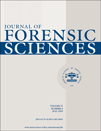The Effects of Different Maceration Techniques on Nuclear DNA Amplification Using Human Bone
Abstract
Abstract: Forensic anthropologists routinely macerate human bone for the purposes of identity and trauma analysis, but the heat and chemical treatments used can destroy genetic evidence. As a follow-up to a previous study on nuclear DNA recovery that used pig ribs, this study utilizes human skeletal remains treated with various bone maceration techniques for nuclear DNA amplification using the standard Combined DNA Index System (CODIS) markers. DNA was extracted from 18 samples of human lower leg bones subjected to nine chemical and heat maceration techniques. Genotyping was carried out using the AmpFℓSTR® COfiler® and AmpFℓSTR® Profiler Plus® ID kits. Results showed that heat treatments via microwave or Biz/Na2CO3 in sub-boiling water efficiently macerate bone and produce amplifiable nuclear DNA for genetic analysis. Long-term use of chemicals such as hydrogen peroxide is discouraged as it results in poor bone quality and has deleterious effects on DNA amplification.




